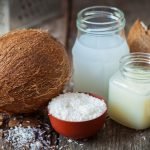Cold Pressed Virgin Coconut Oil Recipe
Prep time
48 hours
Total time
48 hours
Serves: About ½ cup
Equipment
- screwdriver/hammer
- Food processor or blender
- cheesecloth/fine mesh strainer
Ingredients
- 3 large coconuts
Instructions
- Carefully make a hole into the coconut and drain the coconut water.
- Next you will need to crack open the coconuts and take out the harder part of the coconuts. The best way to do this is to wedge screwdriver or something blunt in between the shell and white coconut meat and piercing it out.
- Work in small batches (so that you don't over heat your blender) and blend the coconut meat with water, using a 1:1 ratio. You'll need to use scales for this. Carry on blending until you reach creamy consistency. (If you don't have a blender you can grate the coconut on a fine grater, but blender will give you better results)
- Pour everything into a large plastic bowl and use your clean hands to squeeze the coconut pulp for about 20-30 minutes. This helps to release the oils from the coconut pulp.
- Leave the coconut pulp to sit for a few hours.
- Working in small batches, push all the coconut pulp through a cheesecloth or fine mesh strainer. Make sure you get as much water out as possible. You should end up with nearly dry coconut flakes.
- If you want to have an extra yeald, repead the pressing process again.
- At this stage you'll have a coconut milk (which if you want to you can use for drinking, baking or any other uses).
- Cover the bowl with a plastic cover and allow it to sit, undisturbed in a dark, cold place for 1-2 days
- After this time, place the bowl to fridge to chill for a few hours and speed up the process.
- You'll end up with three layers in your bowl. The top is the cream, middle layer is the coconut oil and the bottom is just the water.
- You need to carefully skim off the top layer of cream, which can be used for baking or cheese making.
- Spoon the oil floating on top of the water.
- Filter the oil through a clean cheesecloth.
- Allow the remaining moisture to evaporate for few hours, then place in a jam jar and store in a dry cold cupboard until needed.

